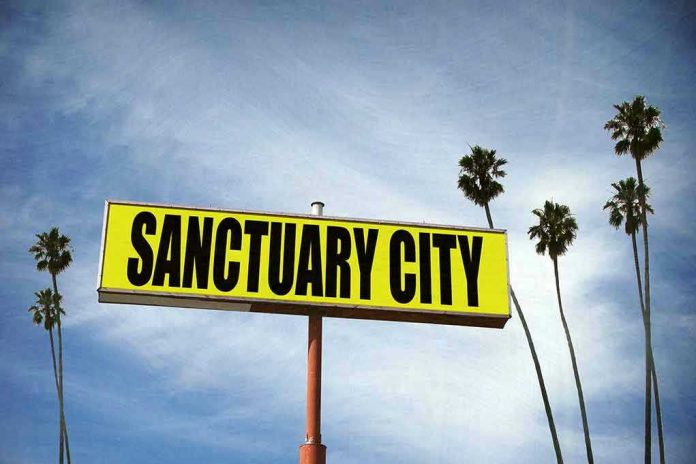
New York’s political establishment reeled as Zohran Mamdani’s $100 million pledge for immigrant deportation defense threatened to upend the rules of the city’s sanctuary game—and left even seasoned lawmakers asking, “Is this for real?”
Story Snapshot
- Assemblyman Mamdani’s $100 million pledge dwarfs past immigrant legal aid funding in NYC
- Less than 200 of 400,000 at-risk immigrants received legal help under prior spending
- The pledge comes amid fierce debate over NYC’s sanctuary city identity and federal immigration pressure
- Lawmakers and advocates are split: Is this bold leadership or political fantasy?
Mamdani’s Pledge: A $100 Million Shockwave Through City Hall
Assemblyman Zohran Mamdani didn’t just raise eyebrows—he detonated a political bomb when he announced, on national television, his plan to pour more than $100 million into defending immigrants facing deportation in New York City. This is not a modest increase. The city’s previous high-water mark for this kind of legal aid hovered just above $60 million, yet still managed to reach only a fraction of the 400,000 New Yorkers at risk of deportation. Mamdani’s pledge more than doubles that commitment, framing his bid not just as funding, but as a battle line in the city’s identity war—who belongs, who is protected, and who decides. The announcement left city lawmakers in disbelief, with some questioning the feasibility, while others saw political genius in the timing and scale.
Mamdani’s supporters trumpet the move as a matter of life and death for immigrant families, while critics in City Hall wonder aloud whether the city’s coffers—and patience—can support such a dramatic shift in priorities. Is this a genuine reimagining of what a sanctuary city means, or just another campaign promise destined to be whittled down in budget negotiations? The answer may determine not just Mamdani’s fate, but the future of immigrant support in America’s most diverse metropolis.
Sanctuary City or Political Stage? Context Behind the Pledge
New York City’s relationship with its immigrant communities is both storied and fraught. Sanctuary policies have long defined the city’s stance, offering protection and support in the face of federal crackdowns. Yet, the numbers tell a sobering story: even with over $60 million spent last year, only a tiny slice of those at risk of deportation gained access to meaningful legal defense. Heightened immigration enforcement and the looming threat of mass deportations have fueled calls for stronger action—and have provided Mamdani with the perfect backdrop for his audacious pledge. Previous mayors have boosted immigrant services, but Mamdani’s move is a quantum leap, challenging the city to match its rhetoric with real resources. The city’s 2026 budget already shows an uptick, with $54.5 million allocated for deportation defense, evidence that the debate Mamdani ignited is far from theoretical. The pledge is forcing a reckoning: what does it truly cost to defend New York’s most vulnerable residents?
Inside City Hall, the tension is palpable. Mayor Eric Adams has overseen increases in legal aid but faces pressure from all sides—progressives demanding more, fiscal hawks warning of financial disaster, and immigrant advocates eager for action. The power struggle is not just about money; it is about defining the city’s soul in an era of political and demographic flux.
Winners, Losers, and the Politics of Protection
The beneficiaries of Mamdani’s pledge—if it becomes reality—are clear: immigrant families fighting for their right to remain in the city they call home, and the legal service providers scrambling to keep up with demand. The losers? That depends on your view. Some see taxpayers carrying an unsustainable burden; others argue that the economic and social dividends of keeping families intact far outweigh the costs. For city politicians, the stakes are existential: Mamdani’s gambit could either cement his place as a visionary or doom his campaign as a cautionary tale of political overreach. The move has already shifted the political center of gravity—Mayor Adams and other city leaders can no longer ignore the call for expanding legal defense. Nationally, the pledge is a shot across the bow, signaling to other cities that sanctuary is not just a slogan but a line-item in the budget.
Critics warn that such aggressive funding could draw the ire of federal authorities and fuel backlash in an already polarized environment. Supporters counter that bold actions are precisely what the moment demands, especially when federal immigration policy remains gridlocked. The debate is now a litmus test for the city’s values and for its willingness to lead on the national stage.
Expert Analysis: Boldness, Risk, and the Next Chapter in NYC Immigration Policy
Legal experts and immigration advocates largely agree that increased legal defense funding dramatically improves outcomes for immigrants facing deportation. Every dollar spent can mean the difference between a family staying together or being torn apart. But the scale of Mamdani’s pledge is almost unprecedented, raising logistical questions about implementation, oversight, and sustained political will. Some academics see the move as a necessary response to a humanitarian crisis, while others caution that such a leap could overwhelm existing systems and provoke unintended consequences. Underneath the policy debate lies a deeper question: can New York, and by extension America, afford not to defend its most vulnerable at this scale? As Mamdani’s pledge reverberates through city politics, the answer remains uncertain—but no longer ignorable. The next mayoral term may well hinge on who owns this issue, and how daringly they are willing to act.
With City Hall divided and public opinion in flux, the stage is set for a showdown that will reveal just how far New York is willing to go to live up to its sanctuary promise—and whether other cities will follow its lead or recoil from the challenge.












